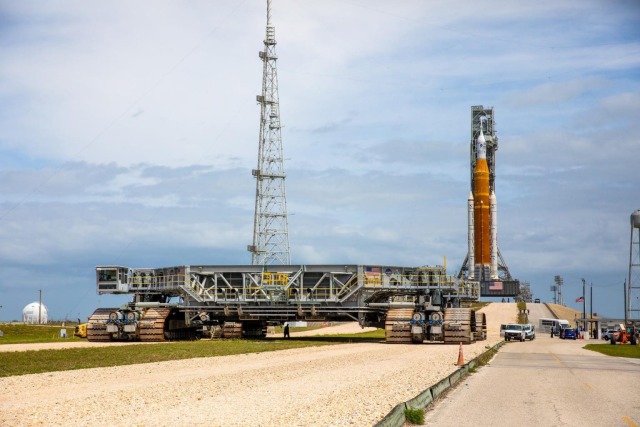The long-suffering Space Launch System rocket with the Orion spacecraft was transported from the launch pad to the vertical assembly building a week and a half ago. It was planned that the entire system would be inspected once again and the shortcomings that prevented the general rehearsal of the launch would be eliminated. However, during the preparation for the repair, suspicious garbage was found, because of which the re-attempt of the final tests is postponed.
Recall that in mid-April, after three interrupted "wet dress rehearsals" of the launch (WDR, wet dress rehearsal), a fully assembled rocket with a spacecraft on it was sent to the VAB hangar (vertical assembly building). There were several problems: some related to the ground infrastructure, the other — directly with the nodes of the Space Launch System (SLS). They decided to roll the carrier under the roof in order to fix the inspection valve of the upper stage and once again inspect the entire structure, which spent almost six weeks in the open air.
In the SLS hangar It turned out to be April 26, and the technical specialists of the US National Aeronautics and Space Administration (NASA) started working. At the same time, employees of the Exploration Ground Systems division (EGS, ground support systems for research missions) were engaged in a previously identified leak on the service mast pipelines. And on May 5, the agency has scheduled a conference to discuss a new date for testing WDR and possible launch windows, taking into account the delay that has already occurred.
For those who have been following the SLS program for a long time, the course of this meeting was hardly a surprise. Yes, all the deadlines are "moving to the right" again. As told by the assistant administrator of EGS Jim Free, a piece of rubber was found in the inspection valve of the second stage (ICPS). The node itself has been fixed, but it is now impossible to move on to the tests according to the schedule. First, you need to install the source of the garbage and fix the problem, if there is one. Just like that, contamination or extra fragments do not appear on such a technique (and if they even appear, then where, how and why is calculated in advance).
So far, the approximate dates look like this. By May 11, a preliminary assessment of the SLS's readiness for a new "wet dress rehearsal" of the launch will be ready. After that, a date will be set for the removal of the rocket with the ship to the launch pad. It will take a lot of time, taking into account all the preparatory measures and necessary checks at each stage. Thus, the WDR will take place sometime in early-mid-June. Well, the launch itself is "moving" to the third of the planned "windows" this summer — from July 26 to August 9.
However, the assistant administrator of EGS noted that neither he nor anyone in the agency can name any specific dates and will not. According to him, given the experience of similar programs in the past, it makes no sense to promise any deadlines — there is a chance of a hitch at every stage of preparation. Safety, reliability and the fulfillment of the mission task are above all, so that no one will rush and turn a blind eye to the smallest shortcomings. It always costs more afterwards. Therefore, Freeh said that he and his colleagues are considering "a couple of time periods throughout August" as opportunities to start.
That is, the launch can move even further than the previously designated "windows". And this, in turn, can lead to another postponement, since the optimal launch dates to the Moon are not issued every day.

